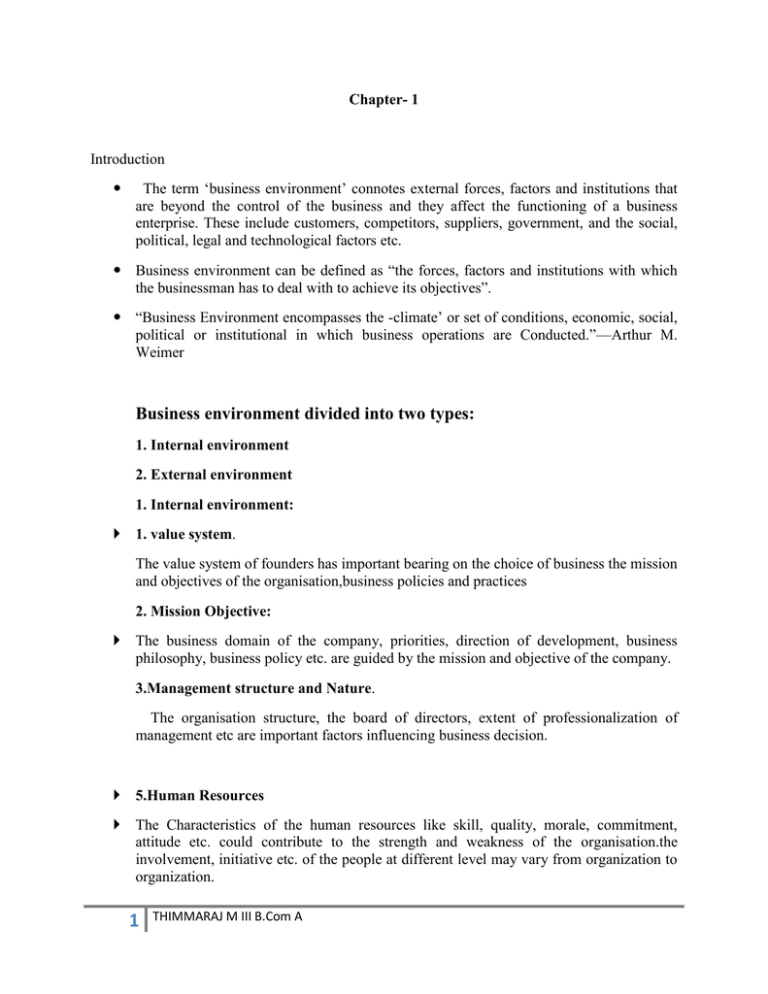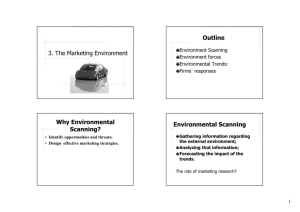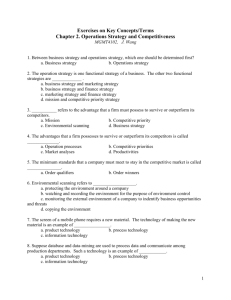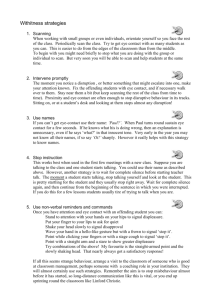Business Environment
advertisement

Chapter- 1 Introduction The term ‘business environment’ connotes external forces, factors and institutions that are beyond the control of the business and they affect the functioning of a business enterprise. These include customers, competitors, suppliers, government, and the social, political, legal and technological factors etc. Business environment can be defined as “the forces, factors and institutions with which the businessman has to deal with to achieve its objectives”. “Business Environment encompasses the -climate’ or set of conditions, economic, social, political or institutional in which business operations are Conducted.”—Arthur M. Weimer Business environment divided into two types: 1. Internal environment 2. External environment 1. Internal environment: 1. value system. The value system of founders has important bearing on the choice of business the mission and objectives of the organisation,business policies and practices 2. Mission Objective: The business domain of the company, priorities, direction of development, business philosophy, business policy etc. are guided by the mission and objective of the company. 3.Management structure and Nature. The organisation structure, the board of directors, extent of professionalization of management etc are important factors influencing business decision. 5.Human Resources The Characteristics of the human resources like skill, quality, morale, commitment, attitude etc. could contribute to the strength and weakness of the organisation.the involvement, initiative etc. of the people at different level may vary from organization to organization. 1 THIMMARAJ M III B.Com A 6.Company image and Brand equity. The image of the company matters while raising finance, forming joint venture or other alliance, market intermediaries, entering purchase or sale contracts, launching new products etc. Internal environment other factors: Physical Assets and facilities. R &D and technological capabilities. Marketing Resources Financial Factors. External Environment: Two types: a) Micro environment. b)Macro environment. Micro Environment of Business These are powers which are deeply related with company and company can control these type of environment by improving its capacity and efficiency. 1. Suppliers : are the persons who supply raw material to company. 2. Customers :are the persons who buy goods from company. 3. Market Intermediaries : are those person who helps company to sell its products. 4. Financial Intermediaries : are those institutions who provide loan, credit and advance to company. 5. Competitors: are those who also sell same product of company. 6. Public : is those group of people who can buy or who can show their interest to buy the products of company. 2 THIMMARAJ M III B.Com A The Macro Environment of Business Macro environment of business means all external factors which affects company and its business and there is no control of company on these factors. 1. Economic Environment it includes govt. budget, import and export policies, economic system and economic conditions. 2. Political and Governmental Environment :it includes legislature's decisions, executive's decisions and judiciary decision which affect company's business. 3. Socio cultural Environment: Socio-cultural environment includes morality, religion, education, health of peoples and family importance 3 THIMMARAJ M III B.Com A 4. Natural Environment: In natural environment, we can include season, place elements, natural resources etc. 5. Demographic Environment: In demographic environment, we can include size of population, growth rate of population, age composition, sex composition and family size. 6.Technological Environment it includes ecommerce technology, online payment, Internet technology, mobile banking and 3G technology and all other new technology which affect company's business. 7. International Environment:it includes rules and regulation of WTO, WB and MNC's affect on our company's Meaning of business Business means all activities which generates wealth. In these activities, goods are produced or purchased and then are sold on profits. Nature/Characteristics of Business The following are the ten important characteristics of a business: 1. Economic activity: Business is an economic activity of production and distribution of goods and services. It provides employment opportunities in different sectors like banking, insurance, transport, industries, trade etc. it is an economic activity corned with creation of utilities for the satisfaction of human wants. It provides a source of income to the society. Business results into generation of employment opportunities thereby leading to growth of the economy. It brings about industrial and economic development of the country. 2. Buying and Selling: The basic activity of any business is trading. The business involves buying of raw material, plants and machinery, stationary, property etc. On the other hand, it sells the finished products to the consumers, wholesaler, retailer etc. Business makes available various goods and services to the different sections of the society. 3. Continuous process: Business is not a single time activity. It is a continuous process of production and distribution of goods and services. A single transaction of trade cannot be termed as a business. A business should be conducted regularly in order to grow and gain regular returns Business should continuously involve in research and developmental activities to gain competitive advantage. A continuous improvement strategy helps to increase profitability of the business firm. 4 THIMMARAJ M III B.Com A 4. Profit Motive: Profit is an indicator of success and failure of business. It is the difference between income and expenses of the business. The primary goal of a business is usually to obtain the highest possible level of profit through the production and sale of goods and services. It is a return on investment. Profit acts as a driving force behind all business activities. Profit is required for survival, growth and expansion of the business. It is clear that every business operates to earn profit. Business has many goals but profit making is the primary goal of every business. It is required to create economic growth. 5. Risk and Uncertainties: Risk is defined as the effect of uncertainty arising on the objectives of the business. Risk is associated with every business. Business is exposed to two types of risk, Insurable and Noninsurable. Insurable risk is predictable. Predictable factors are controllable to some extent, such as: a) Taxes b) Change in the volume of expected sales c) Cost of supplies and equipment d) Overhead costs e) Salaries f) Cost of goods and services offered Unpredictable factors include: a) Changes in trends and tastes of customers. b) Impact of the local economy on customer base. c) Any unexpected action taken by your competitors. The calculation and management of the risk is vital to ensure the success of a business firm. Insurance and Risk management helps in minimizing the risk associated with the business. 6. Creative and Dynamic: Modern business is creative and dynamic in nature. Business firm has to come out with creative ideas, approaches and concepts for production and distribution of goods and services. It means to bring things in fresh, new and inventive way. One has to be innovative because the business operates under constantly changing economic, social and technological environment. Business should also come out with new products to satisfy the growing needs of the consumers. 7. Customer satisfaction: The phase of business has changed from traditional concept to modern concept. Now a day, business adopts a consumer-oriented approach. Customer satisfaction is the ultimate aim of all economic activities. 5 THIMMARAJ M III B.Com A Modern business believes in satisfying the customers by providing quality product at a reasonable price. It emphasize not only on profit but also on customer satisfaction. Consumers are satisfied only when they get real value for their purchase. The purpose of the business is to create and retain the customers. The ability to identify and satisfy the customers is the prime ingredient for the business success. 8. Social Activity: Business is a socio-economic activity. Both business and society are interdependent. Modern business runs in the area of social responsibility. Business has some responsibility towards the society and in turn it needs the support of various social groups like investors, employees, customers, creditors etc. by making goods available to various sections of the society, business performs an important social function and meets social needs. Business needs support of different section of the society for its proper functioning. 9. Government control: Business organisations are subject to government control. They have to follow certain rules and regulations enacted by the government. Government ensures that the business is conducted for social good by keeping effective supervision and control by enacting and amending laws and rules from time to time Some important acts framed by the government include: i. The Competition Act, 2002 ii. Foreign Exchange Management Act, 1999 iii. The Environment Act, 1986 iv. Indian Companies Act, 1956 v. Consumer protection Act 10. Optimum utilisation of resources: Business facilitates optimum utilisation of countries material and non-material resources and achieves economic progress. The scarce resources are brought to its fullest use for concentrating economic wealth and satisfying the needs and wants of the consumers. Objectives of business. a) To earn profit b) To Grow the business c) Innovation of new products 2. Social objectives a) Service to society b) Employee satisfaction and development 6 THIMMARAJ M III B.Com A c) Quality products and services d) Fair return to investors e) Good corporate citizenship BUSINESS OBJECTIVES: OBJECTIVES BUSINESS VISION MISSION VISION: A Vision is a broad explanation of why the firm exists and where it is trying to lead. Where do we go from here? What changes lie ahead in the business landscape? What differences will these changes make to the company’s present business? The vision gives the organisation a sense of purpose and a set of values that unite employees in a common destiny. Vision Of Infosys: “To be globally respected corporation that provides best-of breed business solutions, leveraging technology, vendors and society at large.” MISSION: A mission statement gives the organization its own unique identity, business emphasis and path for development. It incorporates 4 elements. 1. 2. 3. 4. Customer needs (what) Customer groups (Who) The company’s activities, technologies and competencies (How) The company’s concern for survival, its philosophy, its self-concept and its concern for public image Mission Of Infosys: “To achieve our objectives in an environment of fairness, honesty and courtesy towards our clients, employees, vendors and society at large” 7 THIMMARAJ M III B.Com A OBJECTIVES: Objectives represent the operational side of an organization. Mission statements seek to make a vision more specific and objectives are attempts to make mission statements more concrete. CHARACTERISTICS OF CONTEMPORARY BUSINESS or Modern Business When we describe the characteristics of today’s business, we keep in our mind the Indian business. The Indian business has some interesting and unique features such as1. Transition 2. Competition, 3. Opportunities 4. Globalisation 5. Technology 6 .Information 1. Business in Transition: For a long time, business in India was conducted in sheltered markets covering up inefficiencies, low productivity and high cost. Then came 1990s which lifted all protectionist measures. This followed by increased globalisation, changed the scenario altogether. A typical business person is sandwiched between the compulsions of the new business environment and of the old practices of doing business. The Indian business leaders find totally a new environment characterised by competition, both from within and from foreign businesses. Those who are competent are able to survive and those who are not are perishing. 2. Pressure of Competition: As stated above, Indian business are competing among themselves and are exposed to competition from foreign firms. Competition though unwelcome to managers, is a boon to customers. Look at the experience of buyers and users in Indian. Recollect the scenario about 20 years back, Businesses enjoyed visual monopoly and they took advantage of it and squeezed customers. Scarcities, high prices and low quality were the order of the day. The scenario is a contrast today. The customer 8 THIMMARAJ M III B.Com A has a choice. He or she can pick and choose. ‘Customer is the King’ was a mere slogan earlier. Now it is being practised. Competition benefits the consumer as has been proved in our country. Government of India should have realised this fact long back and instead of enacting numerous consumer legislations in the name of protecting consumer’s interests could have allowed competition to play its free role. Not that competition benefits only consumers. It benefits even the rival firms. Computing firms benefit from having strong domestic and foreign rivals. Competition, for example, a. Defines new ways of doing business. b. Helps build new capabilities, c. Builds new customer satisfaction standards, and d. Makes business leaders become proactive. 3. Immense Opportunities: Though Indian business faces stiff competition, it also has plenty of opportunities which can be exploited to one’s advantage. BPO, Call Centres, IT, ITEs, wealth management, risk management and private banking are the new names that are doing rounds in business. But the real opportunities lie in the traditional sector, - viz. industry. Globally competitive manufacturing can be done in India. In diverse sectors like pharmaceuticals, chemicals, textiles, metals, refining, cement, auto and ancillaries, India has factories doing well and even exporting large portions of their output. Many MNCs look at India as export-base. India has potential to emerge as the second global manufacturing base after China. In its recent report ‘Made in India’, McKinsey and Co. has stated that the second and much bigger wave of manufacturing outsourcing is yet to come. Some examples of companies seizing opportunities are worth recollecting. Toyota Kirloskar’s Bidadi Plant, near Bangalore has the highest yield of steel plates in the Asian operation of Toyota. This means that the Indian engineers and their innovations are able to make more money out of steel than elsewhere in the vast Toyota World. Ford’s Sriperambadur plant, near Chennai is at the top among all Ford’s plants worldwide, in terms of production efficiency. The plant now exports engines and panes to South Africa 9 THIMMARAJ M III B.Com A among others. Bajaj Auto’s new plant at Chakan is world class. Tata Motor’s Nano is perhaps the cheapest car in the world etc. 4. Globalization: Going international is yet another trend followed by modern business houses. Modern business necessitates globalisation. Technological innovation, crumbling trade barriers, FDI, information explosion infusing of market competition, changing life styles and demand for new products are the triggers of globalisation. Political boundaries are no barriers to business. Production facilities are being set-up in different countries and products are being sold through a global network. Gradually, business houses are exposed to global competition which argues well for consumers. Infact, internationalism or globalisation is fast becoming imperative for modern business due to technological innovations; crumbling trade barriers; global flow of capital and technology; information explosion; intensity of market competition; changing life styles and the demand for new products. The success achieved by Japan and Other Asian countries has demonstrated that imaginative and supportive economic and trade policies – domestic and external, accent on technological innovation, product design, quality, price, marketing strategy and infrastructure back-up play a vital role in carving a niche in the international business arena. Internationalisation of business is a means of sustaining a strong domestic base in terms of technology, product, market and the capital over a longer period. 5. Technology: Business is characterised by increasing use of technology. The impact of technology on business is pervasive. The way production function is organized; the way products are marketed; the way employees are hired and motivated; the way finance function is carried on; and the way managers and subordinates communicate with each other-all are influenced by technology. Because of its significance, we have devoted a full section to discuss the various dimensions of technology. 6. Information: Another characteristic of contemporary business is the recognition of and the need for information. The whole area is retrieving and extending information, including data processing, information systems analysis and preparation of effective 10 THIMMARAJ M III B.Com A records and reports, has achieved a major status. The complexities of modern business and government requirements have spearheaded this growth. But the vital reason for progress in this area is the availability of the computer and electronic devices that have made feasible the quick and accurate gathering, processing and distributing information. Man is now free from the drudgery of much detailed paperwork. He can further enhance progress by feeding proper information to proper people. Meanwhile, Information technology itself is subject to revolutionary changes. From a handwritten sheet of paper to typing to stencil cutting to photocopying to floppies to cyberspace, the advancement in information technology is commendable. As business gets globalized, online communication across the world would be highly useful. This can be seen in all spheres of human endeavour to succeed. - Features of business environment: The main features of business environment are: 1. All the external forces: Business Environment includes all the forces, institutions and factors which directly or indirectly affect the Business Organizations. 2. Specific and general forces: Business environment includes specific forces such as investors, customers, competitors and suppliers. Non-human or general forces are Social, Legal, Technological, Political, etc. which affect the Business indirectly. 3. Inter-relation: All the forces and factors of Business Environment are inter-related to each other. 4. Uncertainty: It is very difficult to predict the changes of Business Environment. As environment is changing very fast for example in IT, fashion industry frequent and fast changes are taking place 5. Dynamic: Business environment is highly flexible and keep changing. It is not static or rigid that is why it is essential to monitor and scan the business environment continuously. 6. Complex: It is very difficult to understand the impact of Business environment on the companies. Although it is easy to scan the environment but it is very difficult to know how these changes will influence Business decisions. 7. Relativity: 11 THIMMARAJ M III B.Com A The impact of Business environment may differ from company to company or country to country. For example, when consumer organizations published the report of finding pesticides in cold drinks, resulted in decrease in sale of cold drinks, on the other hand it increased the sale of juice and other drinks. To conclude: Business environment is the sum total of all factors external to the business firm and that greatly influence their functioning. It covers factors and forces like customers, competitors, suppliers, government, and the social, cultural, political, technological and legal conditions The business environment is dynamic in nature, that means, it keeps on changing. The changes in business environment are unpredictable. It is very difficult to predict the exact nature of future happenings and the changes in economic and social environment. Business Environment differs from place to place, region to region and country to country. Political conditions in India differ from those in Pakistan. Taste and values cherished by people in India and China vary considerably IMPORTANCE OF BUSINESS ENVIRONMENT (a) Determining Opportunities and Threats: The interaction between the business and its environment would identify opportunities for and threats to the business. It helps the business enterprises for meeting the challenges successfully. (b) Giving Direction for Growth: The interaction with the environment leads to opening up new frontiers of growth for the business firms. It enables the business to identify the areas for growth and expansion of their activities. (c) Continuous Learning: Environmental analysis makes the task of managers easier in dealing with business challenges. The managers are motivated to continuously update their knowledge, understanding and skills to meet the predicted changes in realm of business. (d) Image Building: Environmental understanding helps the business organisations in improving their image by showing their sensitivity to the environment within which they are working. (e) Meeting Competition: It helps the firms to analyse the competitors’ strategies and formulate their own strategies accordingly. (f) Identifying Firm’s Strength and Weakness: Business environment helps to identify the individual strengths and weaknesses in view of the technological and global developments. PEST Analysis Application PEST analysis stands for "Political, Economic, Social-cultural, and Technological analysis" and describes a framework of macro-environmental factors used in the environmental scanning. 12 THIMMARAJ M III B.Com A SWOT Analysis Application A scan of the internal and external environment is an important part of the strategic planning process. Environmental factors internal to the firm usually can be classified as strengths (S) or weaknesses (W), and those external to the firm can be classified as opportunities (O) or threats (T). Such an analysis of the strategic environment is referred to as a SWOT analysis. The SWOT analysis provides information that is helpful in matching the firm's resources and capabilities to the competitive environment in which it operates. As such, it is instrumental in strategy formulation and selection. . Environmental scanning is the monitoring, evaluating, and disseminating of information from the external and internal environment to key people within the corporation or organization. There are three modes by which organizations scan their environment: 1. Ad-hoc scanning 2. Regular scanning 3. continuous scanning Ad-hoc scanning - short term, infrequent examinations usually initiated by a crisis organizations scan it environment as a result of crisis that is affecting the company at the moment and analyze the situation to know if the problem is internal or external. Strategic Environmental Scanning and Organization Performance in a Competitive Business Regular scanning : studies done on a regular schedule (e.g. once a year): most very conscious organizations can see environment scanning as a program that should be done regularly and as such, most of such organizations do it every year; Continuous scanning (also called continuous learning) - continuous structured data collection and processing on a broad range of environmental factors Scanning of internal and external environment is called environmental Scanning. 13 THIMMARAJ M III B.Com A ENVIRONMENTAL ANALYSIS Process of environment Analysis: 1.Scanning 2.Monitoring 3.forecasting 4.Assessment Scanning ASSESSMENT Process of Environmental Analysis Monitoring Forecasting Scanning: Scanning involves general surveillance of all environmental factors and their interactions in order to identify early signals of possible environmental change and also to detect environmental change already underway. Monitoring: Monitoring involves tracking the environmental trends, sequences of events or streams of activities. It is done to assemble sufficient data to discern whether certain trends and patterns are emerging. Three outcomes emerge out of monitoring 1. A specific description of environmental trends and patterns to be forecast. 2. The Identification of trends for further monitoring. 3. The identification of areas for further scanning. Forecasting: Forecasting is concerned with developing plausible projections of the direction, scope and intensity of environmental change. Forecasting is well focused and more specific than the earlier two stages of environmental analysis. Assessment: The outputs of Scanning, monitoring and forecasting are assessed to determine implications for the organization’s current and potential strategies. Assessment 14 THIMMARAJ M III B.Com A involves identifying and evaluating how and why current and projected environmental changes affect or will affect strategic management of the organization. Limitations of Environmental Analysis: It does not foretell the future, nor does it eliminate uncertainty for any organization. Environmental analysis on and off itself, is not a sufficient guarantor of organizational effectiveness. The potential of environmental analysis is often not realized because of how it is practiced. Too much reliance is often placed on the information collected through environmental scanning 15 THIMMARAJ M III B.Com A







